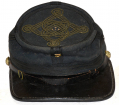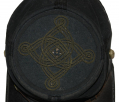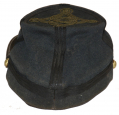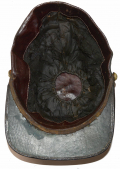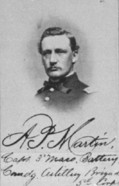site search
online catalog
CAP OF CAPT. AUGUSTUS P. MARTIN, CHIEF OF 5th CORPS ARTILLERY AT GETTYSBURG
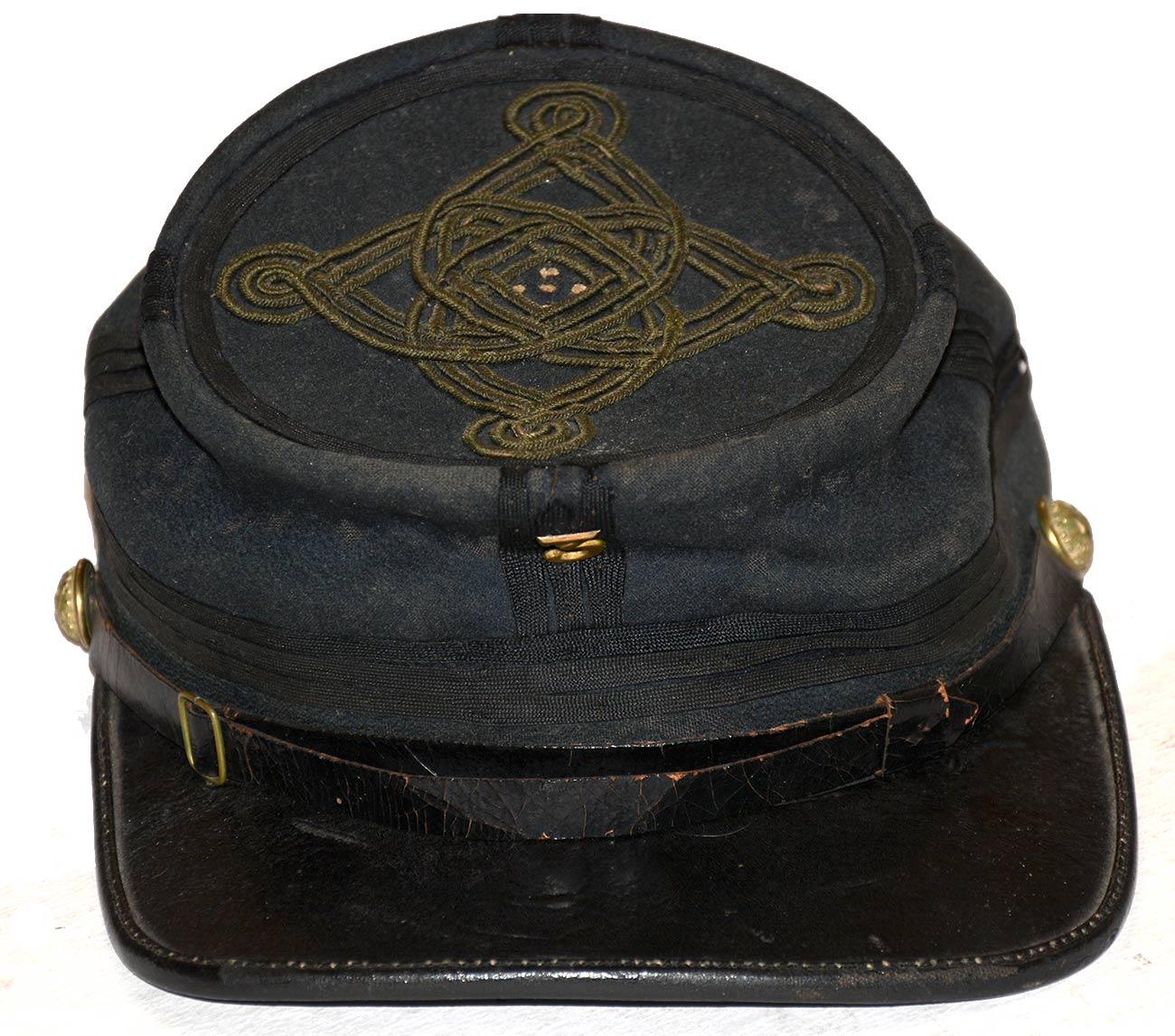
$6,500.00 SOLD
Quantity Available: None
Item Code: 1052-115
Captain Augustus P. Martin has one heck of a fighting record, serving as a Sergeant, Lieutenant and Captain during the war, limited to that wartime rank only because Massachusetts light artillery officers could rise no higher, but serving as a battery commander by late 1861 and detached to act as division chief of artillery in July 1862 and chief of artillery for the entire Fifth Corps, Army of the Potomac at Gettysburg and the later 1863 and the 1864 campaigns in which he was wounded. Despite opportunities for promotion in the heavy artillery, he remained devoted to the light artillery and to his battery, with whom he mustered out 16 September 1864. His low-crown officer’s chasseur-style kepi has his name in old ink on the inside of the chinstrap: “Capt. A. P. Martin” and bears the maker’s or retailer’s logo of George E. Latham of Albany, N.Y., embossed in the center of the leatherette stiffener of the top, and preserves a small brass “3” at top center front, in token of his membership in the 3rd Mass. Battery Light Artillery. This cap first surfaced in 2008 in Gary Hendershott’s catalog 140 of October 2008.
Constructed of dark blue wool, it has a bound visor, ½” wide chinstrap with sewn friction buckle and standing loop, secured by small general staff buttons at either side. The front of the cap stands about 2 1/2” tall, from the top of the visor and has a small brass “3” attached to it just below the top edge. Three flat bands of black tape circle the base of the cap and the front, back, and sides each have three bands up running up an over the rolled edge running around the top of the cap, which has a single, similar, band around its perimeter. At the center of the top is an elaborate quatrefoil of three strands of braid, black, but oxidizing slightly toward brown. While in theory a captain might use just two rows of braid on his cap, this was inconsistently observed, as numerous examples make clear- see, for example, Langellier and Loane, 100-101. Martin punched five small holes in the top for ventilation, a nice indication of real filed use. These are small and concealed partly by the cording. The chinstrap is securely in place and is inscribed inside in ink, “Capt. A.P. Martin” on the end with the standing loop. The loop has become detached from the end of the strap, but is in place and the strap can be tucked inside it for display.
The condition is very good. The dark blue body shows just slight fading from exposure. The black tape on the base and sides has good color. The cording on top has shifted slightly toward brown. We see just one small moth nip and a bit of light tracking on the wearer’s upper right. The lower edge shows minor rubbing from wear but the red Morocco sweatband is in place inside and in good condition. The interior is lightly lined on the sides and has a two-thirds black silk lining largely intact but showing some tears shredding from wear. The lining is the two-thirds style, open at the top, showing a brown leather or leatherette stiffener that is embossed with Latham’s logo, reading: “LATHAM / [? 0 ?] / BROADWAY / ALBANY” with the address number on Broadway partially obscured by the ventilation holes, but with a “0” clearly as a middle digit. According to Bazelon, Latham was doing business at 508 Broadway in 1861 and 1862, and moved at some time in 1863 to 558 Broadway. Neither this nor any previous or later address fits the “0” of the address in the cap.
Born in 1835, Martin was a salesman for a boot and shoe company in Boston before the war and had been a member of a Massachusetts militia light artillery battery since 1854. He received a commission as 2nd Lieutenant in 1858, which he resigned in 1860, but remained in the unit and answered the Governor’s call for troops in April 1861, enlisting for three months with Cook’s Battery as sergeant and chief of gun #1. The battery left Boston on the night of April 20 and arrived at Annapolis by rail and then steamer on April 24. They served there until May when they were sent to Baltimore and posted at the Relay House protecting the railroad lines and were the subjects of some early war photographs. They mustered out August 2 and returned to Boston, where Martin reenlisted, receiving a commission as 1st Lieutenant of Follet’s 3rd Battery Mass. Light artillery on Sept. 5, and a promotion to captain and commander of the battery on Nov. 28.
Since Massachusetts light artillery were independent batteries, rather than in regimental organizations, the Secretary of War later refused to promote any of its officers beyond the rank of captain. Martin was devoted to the light artillery- he later declined appointment as lieutenant colonel in a heavy artillery regiment, which meant he remained a captain until mustering out with the battery in September 1864, despite extensive combat experience and expanding responsibilities: the battery spent its entire service in the Army of the Potomac, attached to the 5th Corps and in July 1862 he was made Chief of Artillery 1st Division 5th Army Corps, and in 16 June, when batteries were grouped into a single “brigade” in each corps, he became Chief of Artillery for the entire 5th Army Corps. In this post he played a key role at Gettysburg on July 2 in the fighting on the Union left and it was a post in which he continued to serve, ranking only as a captain, despite a recommendation for promotion to field grade by General Porter as early as October 1862 and the fact that his later responsibilities as corps chief of artillery merited the rank of brigadier general in the view of Massachusetts Governor Andrews.
At Gettysburg he played a key role in placing Union 5th Corps artillery on Little Round Top and other key positions to reinforce Sickles. Even so, he personally counted Gaines Mill as one of his hardest fought engagements: using double canister, his battery three times held off Confederate attacks that reached as close as 100 yards, some of the last rounds being fired even with the rammers still in the muzzles of the guns. Despite the loss of guns in other Union batteries that day, he escaped with the loss of only one, and that in a creek while pulling back in the general federal retreat. He was also wounded in the neck during the fighting near Spottsylvania in 1864. Upon leaving the army he received numerous letters of thanks and commendation, including one from Meade, and several March 1865 brevets.
He returned to the boot and shoe business in Boston, eventually forming his own company and prospered, holding also a number of civic offices, including Mayor of Boston in 1884, and maintaining his membership in Massachusetts National Guard, in which he rose in 1882 to brigadier general on the staff of the governor. He became a member of the Ancient and Honorable Artillery Company and was also active in veterans’ affairs, being commander of the Massachusetts chapter of MOLLUS. He died in 1902.
In 1879 Martin presented his sword to the museum of the Ancient and Honorable Artillery Company, having it inscribed with all the battles in which he had taken part. According to one source this included Yorktown, Siege of Yorktown, Hanover Court House, Mechanicsville, Gaines Mill, Malvern Hill, Harrison’s Landing, Manassas, Antietam, Leestown, Fredericksburg, Chancellorsville, Middleburg, Aldie, Gettysburg, Rappahannock Station, New Hope Church, Mine Run, Bristoe Station, Wilderness, Laurel Hill, Spottsylvania Court House, Petersburg, Siege of Petersburg, and Weldon Railroad.
This is a great cap from a real combat officer in the Army of the Potomac. [sr] [ph:L]
~~~~~~~~~~~~~~~~~~~~~~~~~~~~~~~~~~~
THIS ITEM, AS WITH ALL OTHER ITEMS AVAILABLE ON OUR WEB SITE,
MAY BE PURCHASED THROUGH OUR LAYAWAY PROGRAM.
CLICK HERE FOR OUR POLICIES AND TERMS.
THANK YOU!
Inquire About CAP OF CAPT. AUGUSTUS P. MARTIN, CHIEF OF 5th CORPS ARTILLERY AT GETTYSBURG
For inquiries, please email us at [email protected]
Most Popular
Historical Firearms Stolen From The National Civil War Museum In Harrisburg, Pa »
Theft From Gravesite Of Gen. John Reynolds »
Selection Of Unframed Prints By Don Troiani »
Fine Condition Brass Infantry Bugle Insignia »
British Imported, Confederate Used Bayonet »
Scarce New Model 1865 Sharps Still In Percussion Near Factory New »
featured item
A RARE SURVIVOR: EARLY-WAR CONFEDERATE MARKED BRITISH P53 ARTILLERY CARBINE #1500 WITH A TENNESSEE PROVENANCE
British artillery carbines were used by both Confederate cavalry and infantry: in October 1862 Jeb Stuart wanted to exchange rifles carried by some his troopers for “Enfield carbines (artillery) in the hands of our infantry.” This is one of just… (846-571). Learn More »
site search
Upcoming Events
May 16 - 18: N-SSA Spring Nationals, Fort Shenandoah, Winchester, VA Learn More »



